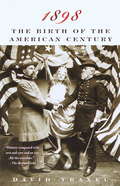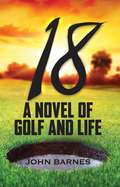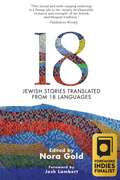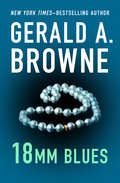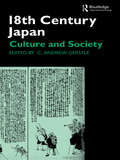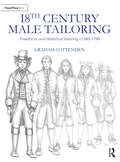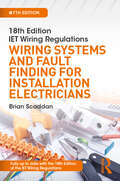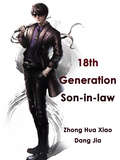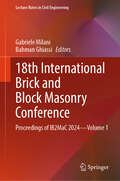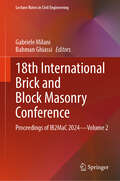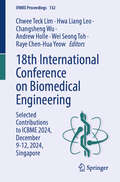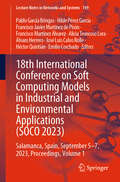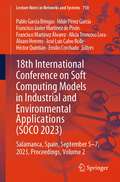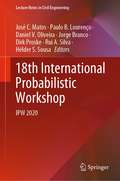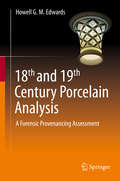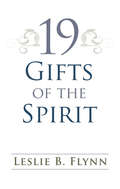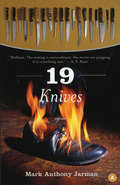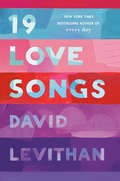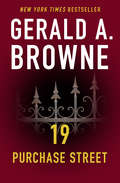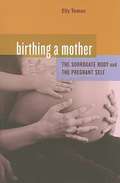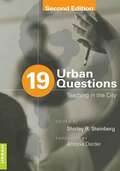- Table View
- List View
189 Canaries
by Dieter BögeIn a cozy room in northern Germany, a yellow canary sings rolling melodies to the miners and carpenters of the Harz mountains. But today a bird dealer has come, and he will take the canary far, far away from everything he knows. The journey leads onto trains and steamships, across Europe and even the Atlantic. At last the canary arrives in a room in New York where he hears a strangely familiar song…This beautiful, poignant book introduces readers to the little-known history of a beloved songbird. Lushly illustrated in rich colors, 189 Canaries is an unforgettable story about music, migration, and the search for home.
1898: The Birth of the American Century
by David TraxelHistorian Traxel narrates the extraordinary events of 1898 to unfold the story of America's metamorphosis from a rural, isolationist society into a commanding presence on the world stage. The account centers upon America's first foray into international military affairs, the Spanish-American War, but also covers worker uprisings, racial conflict, the last battle between Native Americans and the US Army, advances in technology, and the growing importance of advertising. Annotation c. by Book News, Inc. , Portland, Or.
18: A Novel Of Golf And Life
by John BarnesCraig Cantwell is well known as a journeyman millionaire and 'the best professional golfer who has not won a major.' His successful life as a tour pro is shattered when he is suspended from the PGA Tour. Without a place to compete and with a personal life tangled with drama, Craig has to find his way back to a life he knows. His fight is not with the scions of the tour, the public, or the scores of great golfers who would be his opponents. He has to prevail over the toughest of adversaries - himself. "18" beautifully tells the story of Cantwell and those in his life: Rachelle Keys, the mother of Craig's daughter and a heroic FBI Agent. Kelly Keys, the new 'IT' girl of golf. Thomas Kincaid, agent and lawyer to the rich and scandalous. And Seth Reede, the personal development guru with a past more shocking than any fallen hero. Far more involved than just a tale of athletic triumph, "18" is a story of forgiveness, truth, courage, and redemption.
18: Jewish Stories Translated From 18 Languages
by Nora GoldA 2023 Foreword INDIES Book of the Year Finalist in the Anthologies Category This anthology, the first of this kind in twenty-five years, collects eighteen astounding works of Jewish fiction. This is the first anthology of translated multilingual Jewish fiction in 25 years: a collection of 18 splendid stories, each translated into English from a different language: Albanian, Croatian, Czech, Danish, French, German, Greek, Hebrew, Hungarian, Italian, Ladino, Polish, Portuguese, Romanian, Russian, Spanish, Turkish, and Yiddish. These compelling, humorous, and moving stories, written by eminent authors that include Shmuel Yosef Agnon, Isaac Babel, and Lili Berger, reflect both the diversities and the commonalities within Jewish culture, and will make you laugh, cry, and think. This beautiful book is easily accessible and enjoyable not only for Jewish readers, but for story-lovers of all backgrounds. Authors (in the order they appear in the book) include: Elie Wiesel, Varda Fiszbein, S. Y. Agnon, Gábor T. Szántó, Jasminka Domaš, Augusto Segre, Lili Berger, Peter Sichrovsky, Maciej Płaza, Entela Kasi, Norman Manea, Luize Valente, Eliya Karmona, Birte Kont, Michel Fais, Irena Dousková, Mario Levi, and Isaac Babel.
18mm Blues
by Gerald A. BrowneOff the coast of Burma Two women pearl divers found a handful of unheard of blue pearls, 18 millimeters in diameter. As a reward, they were savage. Grady and Julia search for the truth and pearls.
18mm Blues
by Gerald A. BrowneA gem dealer caught up in a decades-old murder mystery searches for the world&’s most precious and mysterious pearls in New York Times–bestselling author Gerald A. Browne&’s exotic, riveting thriller When Grady Bowman and his new girlfriend, Julia Elkins, travel from San Francisco to the Far East to get Grady back into the gem business, a jeweler in Bangkok tells them the extraordinary true story of two female Japanese pearl divers who discovered in the Andaman Sea an oyster bed filled with priceless, naturally blue pearls. The divers were murdered for what they found, and now the son of one of the divers wants revenge. As Grady and Julia hunt for the source of the priceless pearls, they are led to the estate and oyster farms of the world&’s wealthiest pearl dealer. Here Julia becomes increasingly obsessed with the divers&’ tragic deaths, and she and Grady will unravel an extraordinary mystery of one man&’s obsession and another man&’s crime, and the world&’s most breathtaking naturally blue pearls.
18th Century Japan: Culture and Society
by C. Andrew GerstleThe period of Japanese history before the advent of industrialisation and modernism is of tremendous interest. The essays in this collection show a fascination with the social context behind the development of aesthetics, drama, language, art and philosophy, whether it be the world of the pleasure quarters or the Shogun's court.
18th Century Male Tailoring: Theatrical and Historical Tailoring c1680 – 1790
by Graham Cottenden18th Century Male Tailoring: Theatrical and Historical Tailoring c1680 – 1790 introduces the reader to English eighteenth-century tailoring and covers the drafting of patterns, cutting out in cloth and construction techniques in sequence for the tailoring of waistcoats, breeches and coats. From choosing the right cloth to preparing for the fitting process, this how-to guide will help readers create beautiful, historically accurate eighteenth-century male garments for events and performances. The book contains the following: step-by-step instructions complete with illustrations for students and costumiers who are new to the making of male tailored garments from the eighteenth century; drafting blocks and construction techniques for the different styles through the eighteenth century and patterns, photographs, detailed measurements and articles taken from a variety of male coats, waistcoats and trousers from c1680 – c1790 from museums and collections. 18th Century Male Tailoring is written for costume design and construction students, fashion students and practitioners who have a reasonable working knowledge of sewing and general costume making, but not necessarily of tailoring, drafting patterns, cutting skills and the making of male garments.
18th Edition IET Wiring Regulations: Wiring Systems and Fault Finding for Installation Electricians, 7th ed
by Brian ScaddanThis book deals with an area of practice that many students and non-electricians find particularly challenging. It explains how to interpret circuit diagrams and wiring systems, and outlines the principles of testing before explaining how to apply this knowledge to fault finding in electrical circuits. A handy pocket guide for anybody that needs to be able to trace faults in circuits, whether in domestic, commercial or industrial settings, this book will be extremely useful to electricians, plumbers, heating engineers and intruder alarm installers.
18th Generation Son-in-law: Volume 1 (Volume 1 #1)
by Zhong HuaXiaoDangJiaafter being married for two years his son-in-law yao yuan who never even touched his wife's hands was ridiculed by his brother-in-law as a white dog because he was born with white hair and was bullied by his family one night he received a dream from his great-grandfather only then did he realize that his miserable life was caused by his great-grandfather's gamble a hundred years ago after his great-grandfather cancelled the gamble he started his own hanging life
18th Generation Son-in-law: Volume 2 (Volume 2 #2)
by Zhong HuaXiaoDangJiaafter being married for two years his son-in-law yao yuan who never even touched his wife's hands was ridiculed by his brother-in-law as a white dog because he was born with white hair and was bullied by his family one night he received a dream from his great-grandfather only then did he realize that his miserable life was caused by his great-grandfather's gamble a hundred years ago after his great-grandfather cancelled the gamble he started his own hanging life
18th Generation Son-in-law: Volume 3 (Volume 3 #3)
by Zhong HuaXiaoDangJiaafter being married for two years his son-in-law yao yuan who never even touched his wife's hands was ridiculed by his brother-in-law as a white dog because he was born with white hair and was bullied by his family one night he received a dream from his great-grandfather only then did he realize that his miserable life was caused by his great-grandfather's gamble a hundred years ago after his great-grandfather cancelled the gamble he started his own hanging life
18th International Brick and Block Masonry Conference: Proceedings of IB2MaC 2024—Volume 1 (Lecture Notes in Civil Engineering #613)
by Gabriele Milani Bahman GhiassiThis book highlights the latest advances, innovations, and applications in the field of masonry structures and constructions, as presented by leading international researchers at the 18th International Brick and Block Masonry Conference (IB2MaC), held in Birmingham, UK, on July 21–24, 2024. Conference topics include architecture with masonry, analysis of masonry structures, bricks and blocks, mortars, repair, strengthening and retrofitting, conservation of historical heritage, new construction techniques, seismic engineering, durability and deterioration of materials, energy efficiency, AI, and masonry. The contributions, which were selected by means of a rigorous international peer-review process, present a wealth of exciting ideas that will open novel research directions and foster multidisciplinary collaboration among different specialists.
18th International Brick and Block Masonry Conference: Proceedings of IB2MaC 2024—Volume 2 (Lecture Notes in Civil Engineering #614)
by Gabriele Milani Bahman GhiassiThis book highlights the latest advances, innovations, and applications in the field of masonry structures and constructions, as presented by leading international researchers at the 18th International Brick and Block Masonry Conference (IB2MaC), held in Birmingham, UK, on July 21–24, 2024. Conference topics include architecture with masonry, analysis of masonry structures, bricks and blocks, mortars, repair, strengthening and retrofitting, conservation of historical heritage, new construction techniques, seismic engineering, durability and deterioration of materials, energy efficiency, AI, and masonry. The contributions, which were selected by means of a rigorous international peer-review process, present a wealth of exciting ideas that will open novel research directions and foster multidisciplinary collaboration among different specialists.
18th International Conference on Biomedical Engineering: Selected Contributions to ICBME 2024, December 9-12, 2024, Singapore (IFMBE Proceedings #132)
by Chwee Teck Lim Hwa Liang Leo Changsheng Wu Andrew Holle Wei Seong Toh Raye Chen-Hua YeowThis book presents cutting-edge advancements in biomedical engineering, with a special emphasis on innovation in healthcare technologies. It covers advances in wearable devices, 3D printing applications in biomedicine, as well as computational and experimental advances in biomaterials and biomechanics, together with their applications in clinical settings. Gathering ten selected, peer-reviewed works, presented at the 18th International Conference on Biomedical Engineering (ICBME2024), held on December 9-12, 2024, in Singapore, this volume offers a timely snapshot of research and developments that are expected to accelerate the translation of biomedical engineering research into tangible improvements in human health
18th International Conference on Soft Computing Models in Industrial and Environmental Applications: Salamanca, Spain, September 5–7, 2023, Proceedings, Volume 1 (Lecture Notes in Networks and Systems #749)
by Álvaro Herrero Héctor Quintián Emilio Corchado Francisco Javier Martínez de Pisón Hilde Pérez García Francisco Martínez Álvarez Alicia Troncoso Lora Pablo García Bringas José Luis Calvo RolleThis book of Advances in Intelligent and Soft Computing contains accepted papers presented at SOCO 2023 conference held in the beautiful and historic city of Salamanca (Spain) in September 2023. Soft computing represents a collection or set of computational techniques in machine learning, computer science, and some engineering disciplines, which investigate, simulate, and analyze very complex issues and phenomena. After a through peer-review process, the 18th SOCO 2023 International Program Committee selected 61 papers which are published in these conference proceedings and represents an acceptance rate of 60%. In this relevant edition, a particular emphasis was put on the organization of special sessions. Seven special sessions were organized related to relevant topics such as: Time Series Forecasting in Industrial and Environmental Applications, Technological Foundations and Advanced Applications of Drone Systems, Soft Computing Methods in Manufacturing and Management Systems, Efficiency and Explainability in Machine Learning and Soft Computing, Machine Learning and Computer Vision in Industry 4.0, Genetic and Evolutionary Computation in Real World and Industry, and Soft Computing and Hard Computing for a Data Science Process Model. The selection of papers was extremely rigorous to maintain the high quality of the conference. We want to thank the members of the Program Committees for their hard work during the reviewing process. This is a crucial process for creating a high-standard conference; the SOCO conference would not exist without their help.
18th International Conference on Soft Computing Models in Industrial and Environmental Applications: Salamanca, Spain, September 5–7, 2023, Proceedings, Volume 2 (Lecture Notes in Networks and Systems #750)
by Álvaro Herrero Héctor Quintián Emilio Corchado Francisco Javier Martínez de Pisón Hilde Pérez García Francisco Martínez Álvarez Alicia Troncoso Lora Pablo García Bringas José Luis Calvo RolleThis book of Advances in Intelligent and Soft Computing contains accepted papers presented at SOCO 2023 conference held in the beautiful and historic city of Salamanca (Spain) in September 2023.Soft computing represents a collection or set of computational techniques in machine learning, computer science, and some engineering disciplines, which investigate, simulate, and analyze very complex issues and phenomena.After a through peer-review process, the 18th SOCO 2023 International Program Committee selected 61 papers which are published in these conference proceedings and represents an acceptance rate of 60%. In this relevant edition, a particular emphasis was put on the organization of special sessions. Seven special sessions were organized related to relevant topics such as: Time Series Forecasting in Industrial and Environmental Applications, Technological Foundations and Advanced Applications of Drone Systems, Soft Computing Methods in Manufacturing and Management Systems, Efficiency and Explainability in Machine Learning and Soft Computing, Machine Learning and Computer Vision in Industry 4.0, Genetic and Evolutionary Computation in Real World and Industry, and Soft Computing and Hard Computing for a Data Science Process Model. The selection of papers was extremely rigorous to maintain the high quality of the conference. We want to thank the members of the Program Committees for their hard work during the reviewing process. This is a crucial process for creating a high-standard conference; the SOCO conference would not exist without their help.
18th International Probabilistic Workshop: IPW 2020 (Lecture Notes in Civil Engineering #153)
by Dirk Proske Paulo B. Lourenço Jorge Branco José C. Matos Daniel V. Oliveira Rui A. Silva Hélder S. SousaThis volume presents the proceedings of the 18th International Probabilistic Workshop (IPW), which was held in Guimarães, Portugal in May 2021. Probabilistic methods are currently of crucial importance for research and developments in the field of engineering, which face challenges presented by new materials and technologies and rapidly changing societal needs and values. Contemporary needs related to, for example, performance-based design, service-life design, life-cycle analysis, product optimization, assessment of existing structures and structural robustness give rise to new developments as well as accurate and practically applicable probabilistic and statistical engineering methods to support these developments. These proceedings are a valuable resource for anyone interested in contemporary developments in the field of probabilistic engineering applications.
18th and 19th Century Porcelain Analysis: A Forensic Provenancing Assessment
by Howell G. EdwardsThis book addresses the contributions made by analytical chemistry to the characterisation of 18th and early 19th Century English and Welsh porcelains commencing with the earliest reports of Sir Arthur Church and of Herbert Eccles and Bernard Rackham using chemical digestion techniques and concluding with the most recent instrumental experiments, which together span more than a hundred years of study. From the earliest experiments which required necessarily the sacrifice of significant portions of each specimen, which may already have been damaged , to the latest experiments which needed only microsampling or the non-destructive interrogation of valuable perfect specimens a comprehensive survey is undertaken of more than twenty manufactories of quality porcelains. The correlation is made between the quantitative elemental oxide determinations of the scanning electron microscopic diffraction and Xray fluorescence data and the qualitative molecular spectroscopic Raman data to demonstrate their complementarity and use in the holistic forensic assessment of the origin of the fired procelains ; this will form the groundwork for the adoption of analytical techniques for the attribution of unknown or questionable procelains to their potential source factories . The book will also examine the perception of what constitutes a porcelain and its definitions and examines the assignment of porcelains to types which currently employs the definitions of hard paste , soft paste , hybrid , magnesian and bone china from the conclusions derived from the analytical data and a consideration of the raw materials employed in their manufacturing processes. During the discussion of this analytical evidence several themes and protocols have been established for its utilisation in the potential identification of porcelains and several case studies undertaken for this purpose are cited. The book will be of interest to analytical scientists , to museum ceramics curators and to ceramics historians.
19 Gifts of the Spirit
by Leslie R. FlynnCHARISMATIC? YOU CERTAINLY ARE ... IF YOU ARE A CHRISTIAN AT ALL.But perhaps not in the way the term is frequently used today. Charismata is a Greek word meaning "gifts of grace." It refers to the gifts or special abilities given to Christians by the Holy Spirit--all the gifts, not just speaking in tongues or miracles or healing.* What are the 19 gifts?* Are they all for today?* What is their purpose?* How can we discover and put to use our own gifts?All of these questions, plus a careful examination of gifts revealed in the Bible, are included in this in-depth study, first published in 1974. If you want to know what the Bible says about spiritual gifts, this book is for you.
19 Knives
by Mark JarmanWith characters ranging from the desperate to the obsessive to the wildly comic, Mark Anthony Jarman's 19 Knives employs dazzling linguistic verve and staggering metaphoric powers in every sentence. But Jarman doesn't just write about people, he puts us in their skin so that we feel their frailty and courage. No other contemporary Canadian short-story writer slices up the imaginative excitement, cultural hybridity, and Joycean play of language we see in 19 Knives. With one of the stories shortlisted for the U.S.'s prestigious O. Henry Prize and several others having won prizes or been published in magazines and journals across North America, this collection brings a major fiction writer to the fore.
19 Love Songs
by David LevithanThe New York Times bestselling author of Every Day, Someday, and Two Boys Kissing is back with a short story collection about love--perfect for Valentine's Day or year-round reading! <P><P>A resentful member of a high school Quiz Bowl team with an unrequited crush. A Valentine's Day in the life of Every Day's protagonist "A." <P><P>A return to the characters of Two Boys Kissing.19 Love Songs, from New York Times bestselling author David Levithan, delivers all of these stories and more. <P><P>Born from Levithan's tradition of writing a story for his friends each Valentine's Day, this collection brings all of them to his readers for the first time. With fiction, nonfiction, and a story in verse, there's something for every reader here. Witty, romantic, and honest, teens (and adults) will come to this collection not only on Valentine's Day, but all year round.
19 Purchase Street
by Gerald A. BrowneIn Gerald A. Browne&’s spellbinding New York Times bestseller, a man bent on vengeance infiltrates a cabal of blue-blooded bankers that have taken over the Mafia In a quiet suburb of New York City, a mansion on a gated estate houses one of the most powerful crime syndicates in the United States—an elite Mafia whose dons belong to the finest families that the WASP establishment has to offer. Millions of dollars flow in and out of 19 Purchase Street, toted by bagmen who gladly risk everything to share in the syndicate&’s profits. Nothing disrupts operations—until a courier gets a dangerous idea. To avenge a loved one&’s death, Drew Gainer joins the money-laundering scheme, plotting a billion-dollar heist with the help of a beautiful, daring woman and pitting himself against a ruthless opponent. From New York to Paris to Zurich, Gainer risks his life to become the winner who takes all. But who is really conning whom?
19 Steps Up the Mountain
by Joseph P. BlankIt is the story of Dorothy and Bob DeBolt, who could not resist the appeal of children no one else wanted. Children of different races and nationalities, children with seemingly hopeless physical handicaps and bleak futures. It is the story of the children themselves, each learning what it meant to be loved, and what it was to overcome the most heart rending obstacles. Two parents. Nineteen children. And the single most unforgettable story that will ever leave you with mist in your eyes and joy in your heart. "A tonic for cynical and disheartened readers...This book tells clearly what it takes to be successful parents, especially when J.R.-a blind paraplegic-conquers his fear and makes it up the 19-step staircase 'mountain' alone"
19 Urban Questions: Foreword by Antonia Darder
by Shirley R. Steinberg Joe L. KincheloeThe second edition of 19 Urban Questions: Teaching in the City adds new questions to those in the original volume. Continuing the developing conversation in urban education, the book is provocative in style and rich in detail. Emphasizing the complexity of urban education, Shirley R. Steinberg and the authors ask direct questions about what urban teachers need to know. Their answers are guaranteed to generate both classroom discussion and discourse in the field for years to come. The book not only addresses questions pertaining directly to today’s urban schools, but poses new ones for discussion, teacher education, and urban school research. Steinberg has gathered an impressive cadre of teacher/scholars who are engaged in a socially just urban pedagogy.

